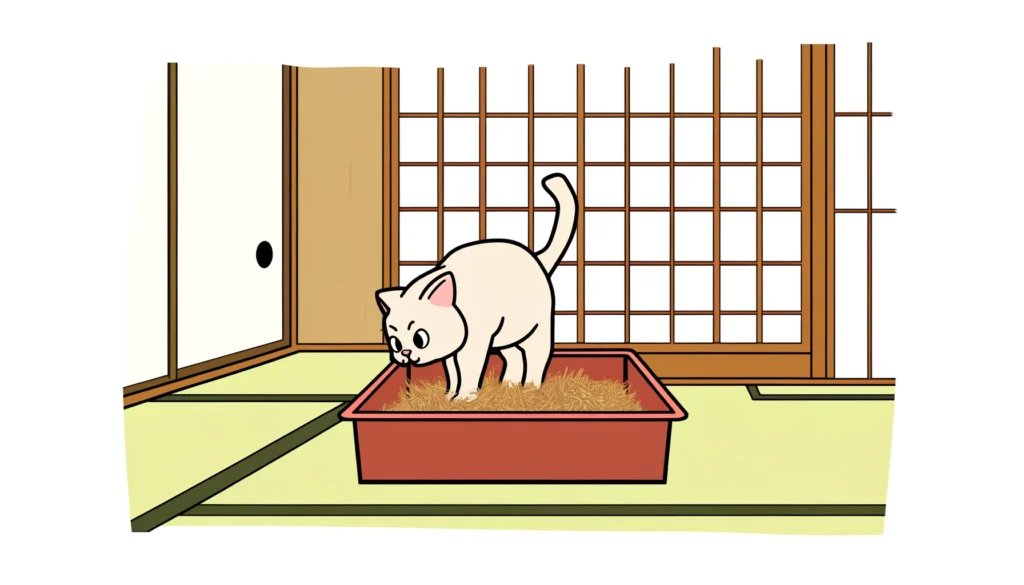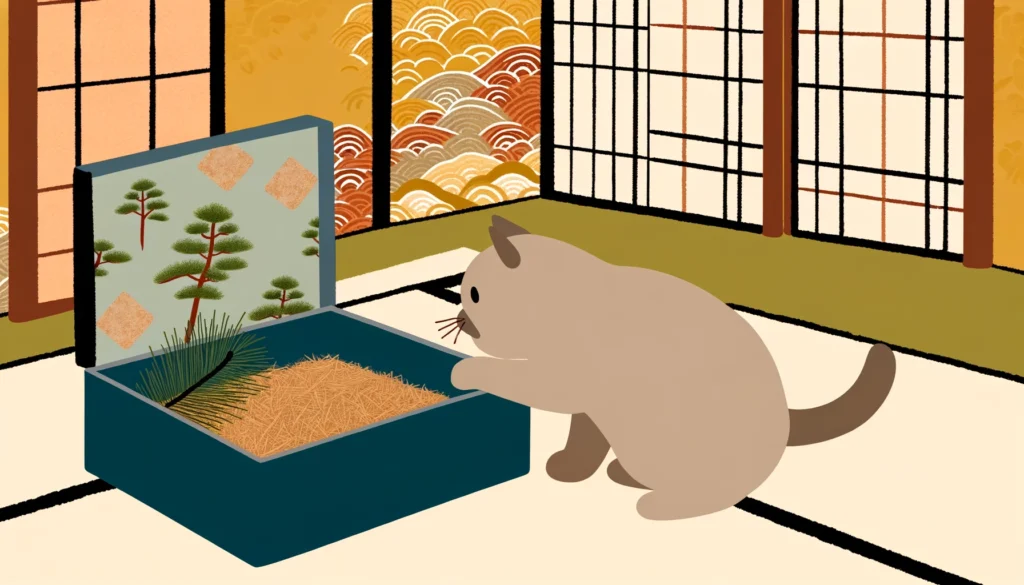Are pine shavings a safe and effective option for cat litter? If you’re pondering whether can you use pine shavings for cat litter, you’re not alone. This question circles among many cat owners looking for sustainable and affordable alternatives to traditional litter options.
With a few tweaks to your regular routine, pine shavings might just be the eco-friendly solution you’re looking for.
To kick off your journey with pine shavings, consider these handy tips:
- Assess the Type: Opt for kiln-dried pine shavings as they are more absorbent and less dusty.
- Ease Into It: Gradually mix pine shavings with your current cat litter to allow your cat to adjust.
- Monitor Your Cat: Keep an eye on how your cat responds to the new litter, especially for any allergic reactions.
Key Takeaways: Are Pine Shavings a Good Choice for Cat Litter?
- Eco-Friendly Alternative: Pine shavings are a sustainable choice, being both biodegradable and sourced from renewable resources.
- Absorbency and Odor Control: They effectively control odors and absorb moisture, making them a practical option for cat litter.
- Cost-Effective: Typically less expensive than many commercial cat litters, offering a budget-friendly alternative for pet owners.
- Health Safety: While generally safe, it’s crucial to choose untreated, dust-free pine shavings to minimize health risks such as respiratory issues or allergic reactions.
- Gradual Transition Recommended: Introduce pine shavings slowly by mixing them with your current cat litter to help your cat adjust without stress.

You may also like – Is Cat Litter Flammable? A List That Are and Aren’t Flammable
What Are Pine Shavings?
Pine shavings, commonly used as bedding for small animals, are now gaining popularity as cat litter. These versatile shavings are more than just bedding; they’re a sustainable choice for eco-conscious pet owners.
- Biodegradable: They break down naturally, much faster than clay litters.
- Low Cost: Generally cheaper than many commercial litters.
- Easy to Source: Available at most farm supply stores.
- Low Dust: Especially the kiln-dried variety, which is better for cats with respiratory issues.
Types of Pine Shavings
From fine to coarse, pine shavings vary widely in their texture. This variety allows pet owners to choose the best option for their furry friends.
- Fine Shavings: Smaller particles that may be softer on paws.
- Medium Shavings: A good balance between absorption and comfort.
- Coarse Shavings: Larger pieces, which are less likely to stick to fur and paws.
Common Uses in Pet Care
Traditionally used for rodents and horses, pine shavings offer several benefits for pet care. Their natural properties make them suitable for a wide range of animals.
- Odor Control: Natural pine scent helps neutralize odors.
- Highly Absorbent: Excellent at soaking up moisture.
- Versatile: Suitable for small pets like guinea pigs and rabbits as well.
Benefits of Using Pine Shavings for Cat Litter
Pine shavings are an eco-friendly cat litter with several distinct advantages. They not only keep your home smelling fresh but also do a solid for the planet. Let’s dig into what makes pine shavings stand out in the world of cat litter alternatives.
Environmental Benefits
Being biodegradable, pine shavings are a more sustainable choice than clay-based litters. They come from a renewable resource and decompose quickly without leaving harmful residues.
- Renewable Resource: Sourced from sustainably managed forests.
- Low Carbon Footprint: Less processing means fewer emissions.
- Compostable: Can be composted after use, reducing landfill waste.
Absorbency and Odor Control
Pine shavings excel in controlling odors and absorbing moisture, making them ideal for a litter box. Their natural properties provide a dual-action solution to keep your cat’s area clean and odor-free.
- High Absorbency: Quickly soaks up moisture to keep the litter box dry.
- Natural Odor Neutralizers: Pine naturally neutralizes ammonia smells.
- Low Tracking: Less likely to be tracked around the house compared to finer litters.
By choosing pine shavings, cat owners can enjoy a fresh-smelling home while contributing to environmental conservation. These benefits highlight why pine shavings could be your next go-to cat litter choice, merging functionality with sustainability seamlessly.

Safety Concerns with Pine Shavings
While pine shavings offer many benefits, potential safety concerns must be addressed. It’s essential to consider both the potential allergens and any chemical treatments that could impact your furry friend’s health.
Allergic Reactions and Respiratory Health
The aromatic oils in pine shavings can sometimes cause allergic reactions or respiratory issues in cats. Not all felines will react the same way, so here’s what to watch out for:
- Symptoms to Monitor: Look for signs of respiratory distress or skin irritation in your cat.
- Ventilation is Key: Ensure the litter area is well-ventilated to minimize inhalation of dust and aromatic compounds.
- Trial Period: Introduce pine shavings gradually to see how your cat adjusts without adverse effects.
Chemical Treatments and Toxins
It’s crucial to consider whether the pine shavings have been treated with chemicals that could be harmful to your cat. Safety first—here’s how to keep your kitty safe:
- Check for Treatments: Ensure the shavings are untreated or specifically marked as safe for pets.
- Source Responsibly: Choose products from reputable manufacturers who guarantee the natural quality of their shavings.
- Regular Updates: Stay informed about any changes in product formulations to keep your cat’s environment safe.
Understanding these safety considerations helps ensure that using pine shavings for cat litter remains a positive choice for both you and your pet. By staying informed and cautious, you can enjoy the benefits of this eco-friendly option without compromising your cat’s health.
How to Safely Switch to Pine Shavings
Transitioning your cat to pine shavings requires careful consideration to ensure their comfort and safety. It’s not just about swapping out the old for the new; it’s about making sure your feline friend adjusts without a hitch!
Gradual Introduction Techniques
Mixing pine shavings with your current cat litter can help your cat adjust slowly. This mixed approach eases them into the new material, letting them explore without stress.
- Mix Ratios: Start with a small amount of pine shavings mixed into their regular litter.
- Observation is Key: Watch how your cat reacts to the new mix.
- Adjust as Needed: Increase the proportion of pine shavings gradually over several weeks.
Choosing the Right Type of Pine Shavings
Select dust-free and untreated pine shavings to avoid health issues. The right type of shavings can make all the difference in ensuring your cat’s health and acceptance.
- Dust-Free Options: Opt for shavings that are specifically marketed as dust-free to reduce respiratory risks.
- Chemical-Free: Ensure the shavings are free from chemicals and other potential irritants.
- Reputable Sources: Purchase from trusted suppliers known for their pet-safe products.
By taking these steps, you ensure a smoother transition for your cat to a new litter solution that’s both environmentally friendly and gentle on their health. The key is patience and attentiveness to your cat’s needs as they get used to their new bathroom basics.

FAQ: Using Pine Shavings for Cat Litter
Q: Are pine wood shavings safe for cats?
A: Kiln-dried pine is generally considered safe as many pet products are treated in this way to remove harmful chemicals. However, some cats may experience skin sensitivities or allergies to pine shavings, potentially causing irritation.
Q: Can you use pine for cat litter?
A: Yes, pine pellets are an effective choice for cat litter. They are all natural, biodegradable, and excel in odor control without artificial fragrances or chemicals. Additionally, they are a sustainable option because they are a recycled product that can continually be recycled.
Q: What can I use as a substitute for cat litter?
A: Alternatives to traditional cat litter include pine wood pellets, wheat-based litter, paper-based kitty litter, coconut coir litter, corn-based litter, and sand. These options are environmentally friendly and vary in absorbency and odor control.
Q: What can I use if I run out of cat litter?
A: In a pinch, sand or wood shavings from a workshop can be used as temporary cat litter. Other materials like puppy pads and potting soil are also viable but come with their own pros and cons regarding absorbency and cleanliness.
Q: Are pine wood shavings harmful to cats?
A: Pine wood shavings are safe for cats if they have been properly treated to remove toxic phenols. However, untreated or raw pine shavings can be harmful and should be avoided.
Q: Is it cheaper to use pine shavings as cat litter?
A: Using pine shavings can be more economical compared to traditional cat litters. They are often sold in bulk for animal bedding, providing a cost-effective solution that is also eco-friendly due to their biodegradability.
Further Reading
Tractor Supply Pine Pellets: Cheap Cat Litter Alternative?
Tractor Supply Natural Pine Pellet Cat Litter Review
Can You Use Wood Shavings For Cat Litter? (Pros & Cons)
Wrapping Up: Pine Shavings as Cat Litter
While pine shavings can be a natural, absorbent option for cat litter, it’s important to weigh the pros and cons carefully. As we’ve explored, pine shavings offer both benefits and considerations that cat owners should take into account.
- Eco-Friendly: They are a sustainable and biodegradable choice.
- Cost-Effective: Generally cheaper than many commercial cat litters.
- Health Considerations: Be aware of potential respiratory issues and chemical exposure.
So, can you use pine shavings for cat litter? Absolutely, but it comes down to making an informed decision based on your cat’s health, your environmental concerns, and your budget.
Are you ready to make the switch, or does the thought stir up more questions? Consider your pet’s needs and your capacity to manage the transition smoothly as you ponder this sustainable shift.


